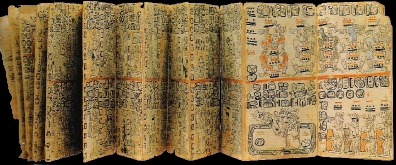
self_id

catalog
contacts

archive

info

SELF_ID
SELF_ID
© 2010 ООО "Self-ID". Авторские права защищены. © 2010 ООО "Self-ID". All Rights Reserved.
Codex of the Maya - ideographic manuscripts of the people of the Maya. Currently, several codes that survived are usually denoted by the city of the libraries where they are located. The themes of the codes were a religion, astronomy and astrology, history, prophecy and divination practices, agricultural cycles and calendar, etc. With their help, the priests interpreted the phenomena of nature and of divine powers and perform religious ceremonies. The codex were written on special paper hun (hun or huun) from the bark of ficus (now a paper called the Aztec word amatl). The first such paper has appeared about the Mayas V century BC. er. [1], around the same time as that of the Romans. Most researchers agree that the Maya of the Yucatan Peninsula were the first in the Americas who began to make paper [2]. It was originally used as a material for clothing and then to transfer information via mail. The paper itself was considered sacred by Mayan. The historian and anthropologist Alan Sendtstrom believes that the paper was high in demand, along with precious stones and metals, feathers, and decorative fabrics. Judging by the remaining codes, they were several meters in length and 20 centimeters in width and consisted of several shorter sheets, glued together. The paper was produced and shipped with standard cords, and then if necessary added as many sheets as required to complete the book. Manufacture of manuscripts was a ritualized process that required specialists who in turn had to comply with the rituals before and after work on a code. Before start drawing, the scribe should have asked the gods to indicate the appropriate time for each stage of work. Also, the priests who read the codes during religious ceremonies and celebrations, had to pass the rituals of purification. It took several days to write a code. First, in black ink on the basis of coal with a kind of "pen" - a sharp tip of the maguey (century plant), or fragments of bones of small animals such as birds, - to draw the outline, after which the parts were painted by a fur brush. Each color had its own value associated with the gods, nature and the cosmos. Creators of the manuscripts were called ah ts'ib (scribes) and ah woh (artists). The vast majority of these were male. A young man who has discovered the ability to draw, held a thorough preparation for several years, studying such subjects as mathematics, astronomy, astrology, cosmology and history. Scribes belonged to the educated elite of society. Patrons of the scribes were god-brothers Hun-Batz and Hun-Chowen, is often portrayed as writing monkeys. At the time of arrival of the conquistadors to the peninsula of Yucatan in the early XVI century, the Maya had already left their main ceremonial center, but the production of paper and a tradition of creating codes were still widespread. First Spanish missionaries were interested in mysterious Native American icons, but when deciphering them with the help of local residents interpreted them as their satanic lies and began their systematic destruction. Bishop Diego de Landa, Yucatan in July 1562 ordered to burn all the codes that fall into the hands of Christians. Afterwards he said: "We have found many books written by these badges, and as they did not contain anything other than superstition and the devil lies, all were burned, which caused them [the Maya] a great sorrow." Alonso de Zorita wrote that in 1540 he saw a set of such manuscripts describing history of local Indians for more than eight hundred years which were translated for him by the most ancient old men [3] in mountains of Guatemala. Bartolome de las Casas complained that hand-written books were destroyed by the monks who were afraid that they can prevent the conversion of local residents into Christianity. The last had been destroyed the codes in the Guatemalan city of Tajjasale accupied in 1697. Nevertheless some codes have got to Europe. To save the books, Maya began to bury them and to hide in caves where they were ruined by high humidity. Only three authentically Mayan codes and a fragment of the fourth somehow reached Europe and many years have lain in oblivion, until they were rediscovered by scientists again. With such poor data the historians of Mesoamerican codes are compelled to resort to reconstruction and indirect sources, such as: ethnobotanical analysis, historical evidences from the second and third hands, ethnobotanical analysis, historical evidence of second-and third-hand, unreliable translations of ideograms Maya, the analysis of images on stone стелах and ceramics and etc. Only four codes have survived, now found in European libraries. They are: ▪ the Dresden code ▪ the Madrid code ▪ the Parisian code ▪ the code of Grole The first two are devoted to astronomy and divination, the third - to the rituals, gods and astrology. The fourth code had remained partially. At excavation, archaeologists found a rectangular pieces agglutinate mass with flakes of paint, mostly in the aristocratic tombs. This is all that remains of the codes, when part of their composition of organic matter had decayed. Several such residues, which traced the drawings have been preserved in hope that someday there will be a technology which will allow to study them. The oldest Mayan codes have been found at excavation of burial places in Uashaktune, Guajtane, the Dignity-agustin-akasaguastlane and Nebahe of different departments of Guatemala, in Altun-Ha in Belize and Kopane in Honduras. Books fromUashaktuna and Altun Ha belong to the early classical period in Nebaj and Copan -Late Classic in Guaytane - Early Postclassic. All these lumps of lime with the remnants of paint, which can not be opened. |
||









































